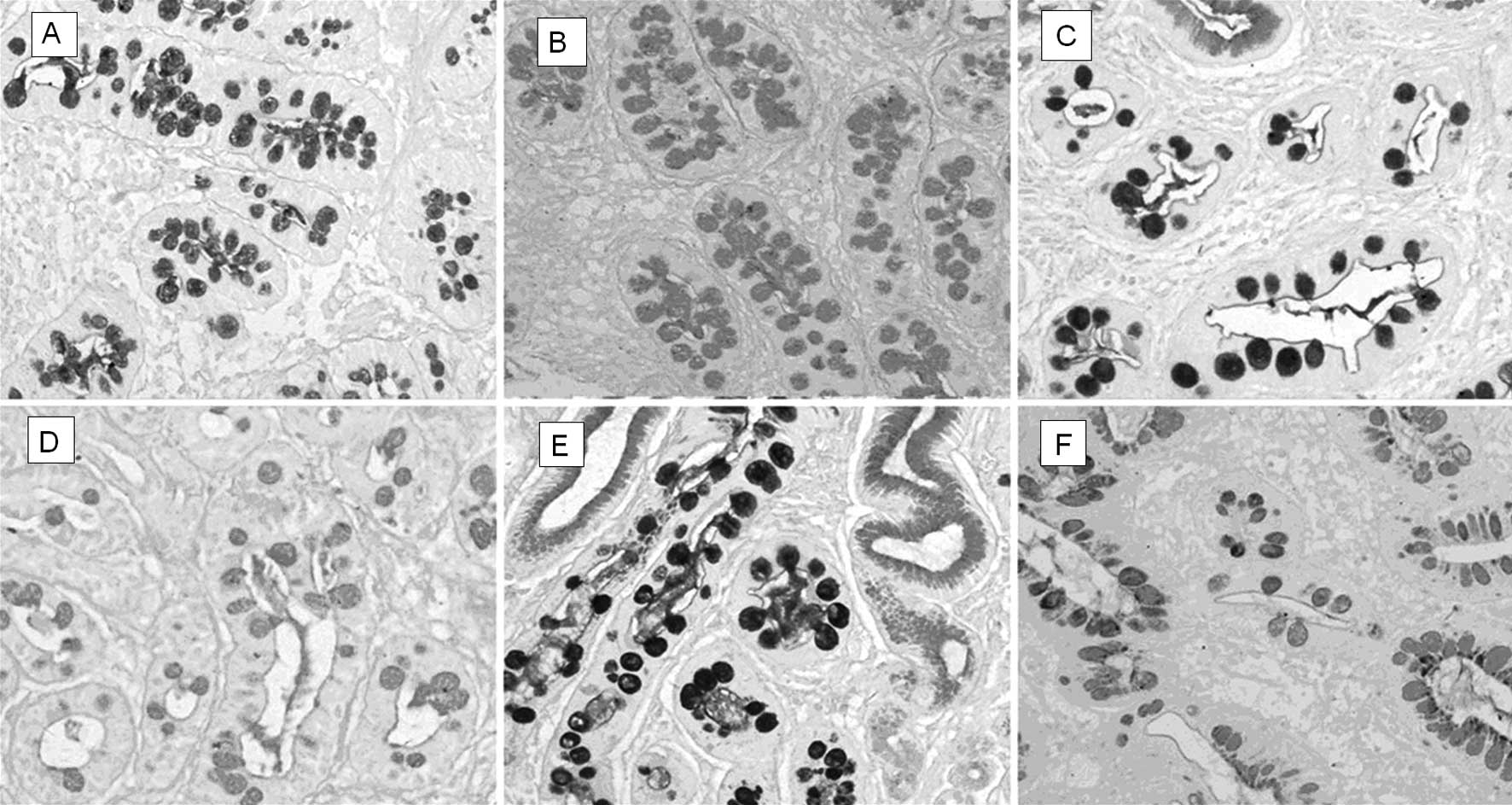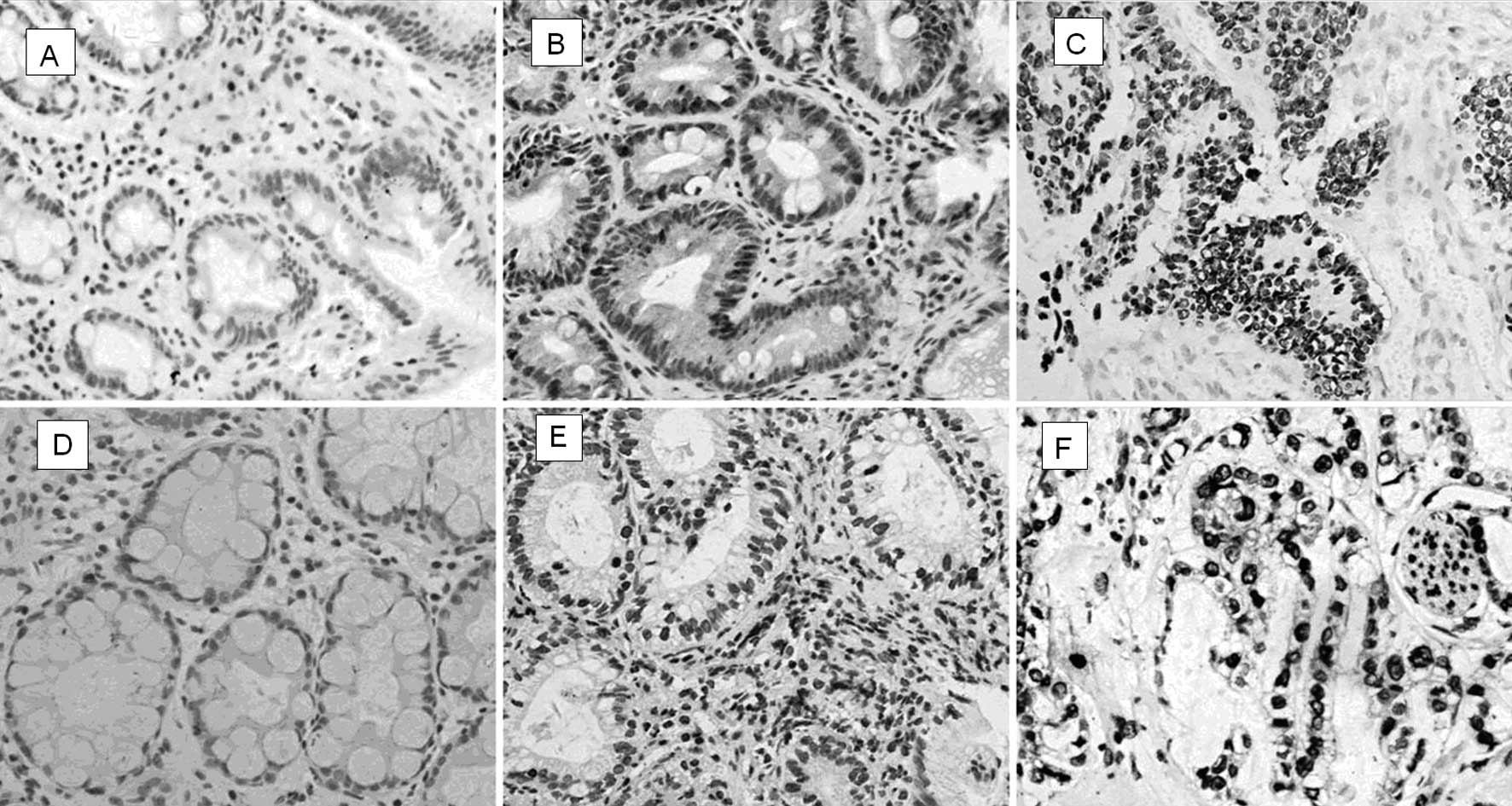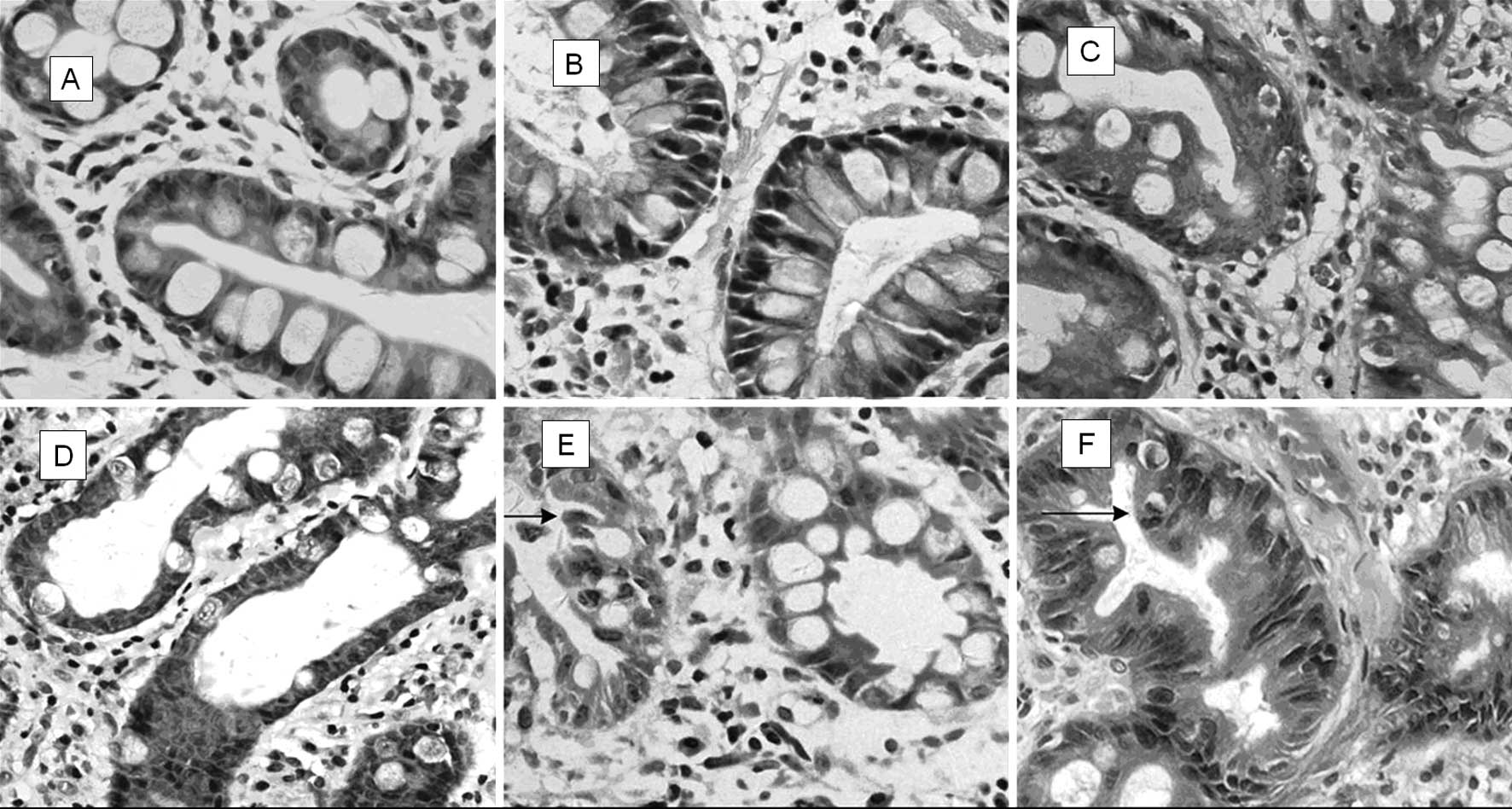|
1
|
Burkitt MD, Varro A and Pritchard DM:
Importance of gastrin in the pathogenesis and treatment of gastric
tumors. World J Gastroenterol. 15:1–16. 2009. View Article : Google Scholar : PubMed/NCBI
|
|
2
|
Chen XM, Chen GY, Wang ZR, Zhu FS, Wang XL
and Zhang X: Detection of micrometastasis of gastric carcinoma in
peripheral blood circulation. World J Gastroenterol. 10:804–808.
2004.PubMed/NCBI
|
|
3
|
Nakajima N, Ito Y, Yokoyama K, Uno A,
Kinukawa N, Nemoto N and Moriyama M: The expression of murine
double minute 2 (MDM2) on helicobacter pylori-infected intestinal
metaplasia and gastric cancer. J Clin Biochem Nutr. 44:196–202.
2009. View Article : Google Scholar : PubMed/NCBI
|
|
4
|
Leung WK and Sung JJ: Review article:
intestinal metaplasia and gastric carcinogenesis. Aliment Pharmacol
Ther. 16:1209–1216. 2002. View Article : Google Scholar : PubMed/NCBI
|
|
5
|
Jass JR: Role of intestinal metaplasia in
the histogenesis of gastric carcinoma. J Clin Pathol. 33:801–881.
1980. View Article : Google Scholar : PubMed/NCBI
|
|
6
|
Jass JR and Filipe MI: A variant
intestinal metaplasia associated with gastric carcinoma: a
histochemical study. Histopathology. 3:191–199. 1979. View Article : Google Scholar : PubMed/NCBI
|
|
7
|
Dixon MF: Campylobacter and chronic
gastritis. Campylobacter and Gastroduodenal Disease. Rathbone BJ
and Heatley RV: Blackwell Scientific Publications; Oxford: pp.
1061–1116. 1989
|
|
8
|
Sipponen P and Hyvainen H: Role of
helicobacter pylori in the pathogenesis of gastric peptic
ulcer and gastric cancer. Scand J Gastroenterol Suppl. 196:3–6.
1993.
|
|
9
|
Dixon MF: Pathophysiology of
helicobacter pylori infection. Scand J Gastroenterol Suppl.
201:7–10. 1994.
|
|
10
|
Rothery GA and Day DW: Intestinal
metaplasia in endoscopic biopsy specimens of gastric mucosa. J Clin
Pathol. 38:613–621. 1985. View Article : Google Scholar : PubMed/NCBI
|
|
11
|
Ectors N and Dixon MF: The prognostic
value of sulphomucin positive intestinal metaplasia in the
development of gastric cancer. Histopathology. 10:1271–1277. 1986.
View Article : Google Scholar : PubMed/NCBI
|
|
12
|
Petersson F, Borch K and Franzén LE:
Prevalence of subtypes of intestinal metaplasia in the general
population and in patients with autoimmune chronic atrophic
gastritis. Scand J Gastroenterol. 37:262–266. 2002. View Article : Google Scholar : PubMed/NCBI
|
|
13
|
Zheng Y, Wang L, Zhang JP, Yang JY, Zhao
ZM and Zhang XY: Expression of p53, c-erbB-2 and Ki67 in intestinal
metaplasia and gastric carcinoma. World J Gastroenterol.
16:339–344. 2010. View Article : Google Scholar : PubMed/NCBI
|
|
14
|
Barak Y, Juven T, Haffner R and Oren M:
mdm2 expression is induced by wild type p53 activity. EMBO J.
12:461–468. 1993.PubMed/NCBI
|
|
15
|
Momand J and Zambetti GP: Mdm-2: ‘big
brother’ of p53. J Cell Biochem. 64:343–352. 1997.
|
|
16
|
Lev Bar-Or R, Maya R, Segel LA, Alon U,
Levine AJ and Oren M: Generation of oscillations by the p53-Mdm2
feedback loop: a theoretical and experimental study. Proc Natl Acad
Sci USA. 97:11250–11255. 2000.PubMed/NCBI
|
|
17
|
Leach FS, Tokino T, Meltzer P, Burrell M,
Oliner JD, Smith S, Hill DE, Sidransky D, Kinzler KW and Vogelstein
B: p53 mutation and MDM2 amplification in human soft tissue
sarcomas. Cancer Res. 53:2231–2234. 1993.PubMed/NCBI
|
|
18
|
Leite KR, Franco MF, Srougi M, Nesrallah
LJ, Nesrallah A, Bevilacqua RG, Darini E, Carvalho CM, Meirelles
MI, Santana I and Camara-Lopes LH: Abnormal expression of MDM2 in
prostate carcinoma. Mod Pathol. 14:428–436. 2001. View Article : Google Scholar : PubMed/NCBI
|
|
19
|
Reis CA, David L, Nielsen PA, Clausen H,
Mirgorodskaya K, Roepstorff P and Sobrinho-Simões M:
Immunohistochemical study of MUC5AC expression in human gastric
carcinomas using a novel monoclonal antibody. Int J Cancer.
74:112–121. 1997. View Article : Google Scholar : PubMed/NCBI
|
|
20
|
Jass JR and Filipe MI: The mucin profile
of normal gastric epithelium, intestinal metaplasia and gastric
carcinoma. Histochem J. 13:831–939. 1981.
|
|
21
|
Hwang JH: To perform a biopsy or not to
perform a biopsy? Does confocal endomicroscopy provide the answer
for surveillance in Barrett’s esophagus? Gastrointest Endosc.
70:655–657. 2009.
|
|
22
|
Liu H, Li YQ, Yu T, Zhao YA, Zhang JP,
Zhang JN, Guo YT, Xie XJ, Zhang TG and Desmond PV: Confocal
endomicroscopy for in vivo detection of microvascular architecture
in normal and malignant lesions of upper gastrointestinal tract. J
Gastroenterol Hepatol. 23:56–61. 2008.PubMed/NCBI
|
|
23
|
Vogelstein B and Kinzler KW: p53 function
and dysfunction. Cell. 70:523–526. 1992. View Article : Google Scholar
|
|
24
|
Harris AL: Mutant p53 - the commonest
genetic abnormality in human cancer? J Pathol. 162:5–6. 1990.
View Article : Google Scholar : PubMed/NCBI
|
|
25
|
Correa P and Shiao YH: Phenotypic and
genotypic events in gastric carcinogenesis. Cancer Res.
54:1941–1943. 1994.PubMed/NCBI
|
|
26
|
Tahara E, Kuniyasu H, Yasui W and Yokozaki
H: Gene alterations in intestinal metaplasia and gastric cancer.
Eur J Gastroenterol Hepatol. 6:97–101. 1994.
|
|
27
|
Shiao YH, Ruqqe M, Correa P, Lehmann HP
and Scheer WD: p53 alteration in gastric precancerous lesions. Am J
Pathol. 144:511–517. 1994.PubMed/NCBI
|
|
28
|
Uchino S, Noguchi M, Ochiai A, Saito T,
Kobayashi M and Hirohashi S: p53 mutation in gastric cancer: a
genetic model for carcinogenesis is common to gastric and
colorectal cancer. Int J Cancer. 54:759–764. 1993. View Article : Google Scholar : PubMed/NCBI
|
|
29
|
Maesawa C, Tamura G, Suzuki Y, Ogasawara
S, Sakata K, Kashiwaba M and Satodate R: The sequential
accumulation of genetic alterations characteristic of the
colorectal adenoma-carcinoma sequence does not occur between
gastric adenoma and adenocarcinoma. J Pathol. 176:249–258. 1995.
View Article : Google Scholar
|
|
30
|
Tamura G, Sato K, Akiyama S, Tsuchiya T,
Endoh Y, Usuba O, Kimura W, Nishizuka S and Motoyama T: Molecular
characterization of undifferentiated-type gastric carcinoma. Lab
Invest. 81:593–598. 2001. View Article : Google Scholar : PubMed/NCBI
|
|
31
|
Ranzani GN, Luinetti O, Padovan LS,
Calistri D, Renault B, Burrel M, Amadori D, Fiocca R and Solcia E:
p53 gene mutations and protein nuclear accumulation are early
events in intestinal type gastric cancer but late events in diffuse
type. Cancer Epidemiol Biomarkers Prev. 4:223–231. 1995.PubMed/NCBI
|
|
32
|
Ochiai A, Yamauchi Y and Hirohashi S: p53
mutations in the non-neoplastic mucosa of the human stomach showing
intestinal metaplasia. Int J Cancer. 69:28–33. 1996. View Article : Google Scholar : PubMed/NCBI
|
|
33
|
Oliner JD, Kinzler KW, Meltzer PS, George
DL and Vogelstein B: Amplification of a gene encoding a
p53-associated protein in human sarcomas. Nature. 358:80–83. 1992.
View Article : Google Scholar : PubMed/NCBI
|
|
34
|
Bueso-Ramos CE, Manshouri T, Haidar MA,
Huh YO, Keating MJ and Albitar M: Multiple patterns of MDM-2
deregulation in human leukemias: implications in leukemogenesis and
prognosis. Leuk Lymphoma. 17:13–18. 1995. View Article : Google Scholar : PubMed/NCBI
|
|
35
|
Iwakuma T and Lozano G: MDM2, an
introduction. Mol Cancer Res. 1:993–1000. 2003.
|
|
36
|
Günther T, Schneider-Stock R, Häckel C,
Kasper HU, Pross M, Hackelsberger A, Lippert H and Roessner A: Mdm2
gene amplification in gastric cancer correlation with expression of
Mdm2 protein and p53 alterations. Mod Pathol. 13:621–626.
2000.PubMed/NCBI
|
|
37
|
Tanière P, Martel-Planche G, Maurici D,
Lombard-Bohas C, Scoazec JY, Montesano R, Berger F and Hainaut P:
Molecular and clinical differences between adenocarcinomas of the
esophagus and of the gastric cardia. Am J Pathol. 158:33–40.
2001.PubMed/NCBI
|

















